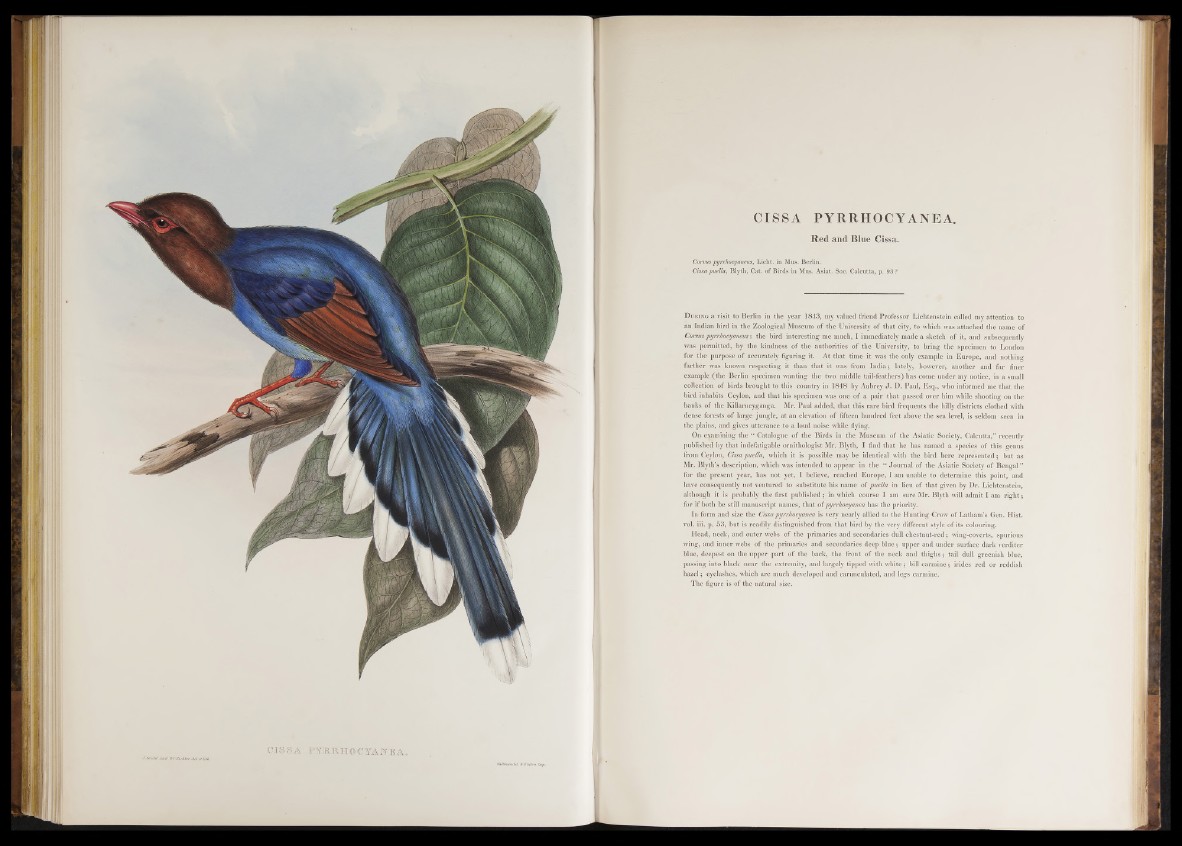
C I S S A IP YE.1R.HC C f l l E A.
CISSA PYRRHOCYANEA.
Red and Blue Cissa.
Corms pyrrhocyaneus, Licht, in Mus. Berlin.
Cissa puetta, Blyth, Cat. o f B irds in Mus. Asiat. Soc. Calcutta, p. 93 ?
D u r in g a visit to Berlin in the year 1843, my valued friend Professor Lichtenstein called my attention to
an Indian bird in the Zoological Museum o f the University of th at city, to which was attached the name of
Corms pyrrhocyaneus: the bird interesting me much, I immediately made a sketch o f it, and subsequently
was permitted, by the kindness of the authorities of the University, to bring the specimen to London
for the purpose of accurately figuring it. At that time it was the only example in Europe, and nothing
farther was known respecting it than that it was from In d ia; lately, however, another and far finer
exaniple. (the Berlin specimen wanting the two middle tail-feathers) has come under my notice, in a small
collection of birds brought to this country in 1848 by Aubrey J . D. Paul, Esq., who informed me that the
bird inhabits Ceylon, and th at his specimen was one o f a pair that passed over him while shooting on the
banks o f the Killarneyganga. Mr. Paul added, that this rare bird frequents the hilly districts clothed with
dense forests o f large jungle, at an elevation of fifteen hundred feet above the sea level, is seldom seen in
the plains, and gives utterance to a loud noise while flying.
On examining the “ Catalogue of the Birds in the Museum of the Asiatic Society, Calcutta,” recently
published by that indefatigable ornithologist Mr. Blyth, I find that he has named a species o f this genus
from Ceylon, Cissa paella, which it is possible maybe identical with the bird here represented; but as
Mr. Blyth’s description, which was intended to appear in the “ Journal of the Asiatic Society of Bengal ”
for the present year, has not yet, I believe, reached Europe, I am unable to determine this point, and
have consequently not ventured to substitute his name of puella in lieu o f that given by Dr. Lichtenstein,
although it is probably the first published; in which course I am sure Mr. Blyth will admit I am r ig h t;
for if both be still manuscript names, that o f pyrrhocyanea has the priority.
In form and size the Cissa pyrrhocyanea is very nearly allied to the Hunting Crow of Latham’s Gen. Hist,
vol. iii. p. 53, but is readily distinguished from that bird by the very different style of its colouring.
Head, neck, and outer webs of the primaries and secondaries dull chestnut-red; wing-coverts, spurious
wing, and inner webs of the primaries and secondaries deep b lu e ; upper and under surface dark verditer
blue, deepest on the upper p art of the back, the front o f the neck and th ig h s; tail dull greenish blue,
passing into black near the extremity, and largely tipped with wh ite; bill carmine; irides red or reddish
hazel; eyelashes, which are much developed and carunculated, and legs carmine.
The fiffure is of the natural size.